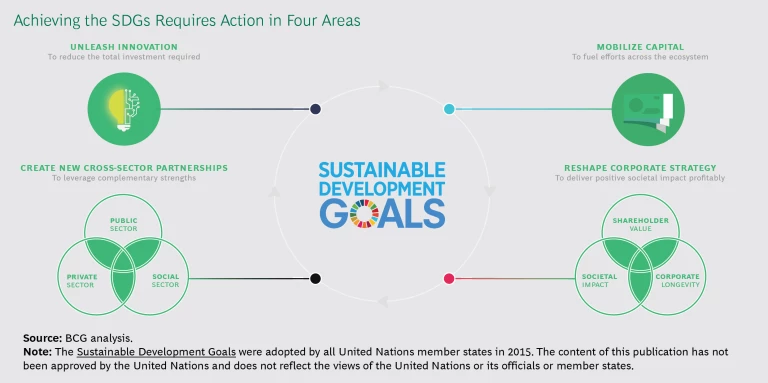As institutions around the world gauge their progress toward achieving the goals outlined in the UN’s 2030 Agenda for Sustainable Development, one thing is clear: We are moving too slowly to keep pace with growing societal needs and are in danger of coming up woefully short of those targets.
It has been clear from the start that considerable new investment is needed to close the nearly $2.5 trillion annual gap between what is being spent today and what would suffice to meet the UN’s 17 ambitious Sustainable Development Goals (SDGs). It is also clear that filling the gap requires the public sector to work effectively with the social sector and to enlist the enormous capacity of the private sector. In response, BCG and other SDG proponents have worked to create new models designed to bring the public, private, and social sectors together in support of the SDGs—including encouraging companies to use their formidable resources and scale to address societal issues and mobilizing new sources of capital.
These moves are critical, but they are not enough. In addition to looking for ways to close the investment gap, we need to rewrite the equation, focusing on how to reduce both the amount of investment necessary and the time needed to achieve results. We can improve in both areas today, but only if we leverage innovation. There are examples of proven technologies and approaches from around the world that, if adapted and deployed at scale, could meaningfully narrow the SDG investment gap. It’s time to get serious about accelerating innovation on our way to meeting the SDGs.
Steps to Bridge the Investment Gap
Proponents of sustainable development have met in dozens of venues around the world to develop a game plan for achieving the SDGs. Unfortunately, all the effort and good intentions have not as yet sufficiently sped progress toward filling the SDG investment gap to meet the 2030 targets. And while the organizations that should be leading the field—multilateral and bilateral development finance institutions and national development agencies—may have the appropriate vision and rhetoric, most of them are not moving quickly enough. They continue to struggle on various fronts: in changing the way they work and organize, in developing the necessary capabilities, and in crafting suitably large development projects quickly enough to absorb the capital that investors are ready to put to work.
Our assessment is that most of the effort to bring more energy and resources to the SDGs today focuses on three important and reinforcing strategies:
- Creating New Cross-Sector Partnerships. The UN has registered more than 4,000 partnerships in the Global Registry of Voluntary Commitments & Multistakeholder Partnerships, some of them targeting specific thematic areas where business can make a difference. These partnerships include Food Reform for Sustainability and Health (FReSH), a global business partnership that uses a consumer-focused, systemic approach to drive progress toward achieving healthy and sustainable global food production by 2030, and the CEO Partnership for Financial Inclusion, which brings together ten global corporations from different sectors to build private-private partnerships to advance financial inclusion.
- Reshaping Corporate Strategy. Many progressive corporations are paying greater attention to environmental, social, and governance (ESG) measures. They are broadening their approach to building competitive advantage and new business in a way that includes thinking deeply about their activities’ impact on environmental sustainability and societal needs—sometimes explicitly in connection with achieving the SDGs. Such efforts demonstrate that companies can rethink how to factor societal issues into corporate strategy and performance and ultimately be rewarded by investors.
- Mobilizing Capital Toward Societal Impact. Capital is flowing into socially responsible investments , new ESG funds, and a range of new SDG-related bond issuances (most of which are oversubscribed), proving that it is possible to mobilize capital toward SDG outcomes. This gives development and social-mission organizations new opportunities to take advantage of private capital.
Innovation: The Big Accelerator
As important as these three strategies are for driving SDG progress, they can too easily focus on filling the SDG investment gap rather than fundamentally altering it. This is not terribly surprising. After all, most of the thinking about and discussion of the SDGs comes from a development mindset. But such conversations are trapped in a cycle of appealing for budgets and delivering on proven programs. This leads planners and decision makers to look at the same interventions and run the same math to estimate what it will take to achieve development outcomes, thus reinforcing those models and programs. It does not stimulate radical and transformative innovation.
As in business, innovation can significantly shift the economics of potential solutions and the timeline for delivering them. New technologies and approaches have the potential to fundamentally alter the cost of achieving progress. That’s why innovation is critical to advancing the SDGs. It can support and advance both company strategies related to societal impact and initiatives undertaken by new cross-sector partnerships. At the same time, the increased mobilization of capital helps fuel efforts in both areas. (See the exhibit.)
Certainly, effective innovation efforts are underway today in many quarters. Most development institutions now have innovation units tasked with boosting their own capacity for innovation and funding new approaches to programming. Multiple crowdsourcing innovation efforts, such as country Innovation Labs, MIT SOLVE, and UNLEASH, are in operation as well. And there are efforts to systematically raise the innovation capacity of countries through processes such as science, technology, and innovation (STI) roadmapping.
Most of these efforts, however, fall short of driving large-scale innovation. Of all the forces that the private sector can bring to bear in attempting to advance the 2030 SDGs, by far the most powerful is its unique capacity to innovate quickly, attract capital to innovative solutions, and drive innovations at scale. That combination is hard to find in the public sector or the social sector, but it’s the private sector’s lifeblood.
Each year, BCG publishes its report on the world’s most innovative companies . Our research identifies what successful innovation models look like and what transformations are necessary to get there. One crucial attribute at the core of such success is a commitment to nurturing a culture that allows new thinking and approaches to emerge and flourish, coupled with an organizational capacity to rapidly scale and deploy innovation.
Numerous examples of innovations highlight the potential impact that advances in innovation could have if they were accelerated and scaled with the help of the private sector:
- Hunger. The United Nations World Food Programme (WFP) launched its Innovation Accelerator in 2016 to identify, support, and scale up new approaches to solving world hunger. One pilot, called Building Blocks, uses blockchain technology to offer Syrian refugees residing in the Azraq camp in Jordan a more secure and efficient way to receive electronic cash transfers . The initiative transformed a process that used to involve lines, paperwork, and manual due diligence into one that takes just seconds. In addition, by automating the cash transfer system and eliminating the need for intermediaries, WFP cut transaction fees by a staggering 98%, freeing up funds that the organization could then redirect toward humanitarian relief. The success of the pilot prompted WFP to expand the initiative in early 2018; currently the program supports more than 100,000 refugees residing in camps across Jordan. WFP and UN Women are now partnering to use the same Building Blocks platform to provide assistance to food-insecure Syrian women in Jordan.
- Sanitation. Safe disposal of waste is a huge challenge in many countries. Lack of adequate sanitation spreads disease, making it a contributor to more deaths globally than measles, malaria, and AIDS combined. The Bill & Melinda Gates Foundation, which is known for emphasizing innovation, has funded innovators of various new, low-cost sanitation technologies , including dry combustion, which converts waste into small blocks of fuel rather than flushing it away with water. Private companies may someday commercialize such technology and seize part of a global market that is expected to reach $6 billion by 2030.
- Safe Water. New technologies can help address the problem of lack of access to clean water that challenges 2.1 billion people around the world. One new approach is a plasma water sanitization system developed by inventor Alfredo Zolezzi that can decontaminate water and rid it of nearly all viruses and bacteria in just two-tenths of a second.
- Education. In India, 2,700 childcare providers are using a mobile app to improve early childhood education. In that country, childcare providers deliver daily caregiving services for children and new mothers, and also teach children who are from three to six years old. That workload that can be overwhelming, seriously limiting their ability to carve out time for actual instruction. The app expands and improves instructional time in several ways. It provides lesson plans for providers and includes videos that demonstrate how to conduct educational activities. It helps motivate providers through the use of game-like features, tracks student outcomes, and allows providers to communicate with parents through personalized messages. The app has gained an impressive level of traction with more than 70% of providers using it daily. More important, the number of childcare providers who spend more than two hours daily on actual instruction has increased by more than 60%.
- Financial Inclusion. This area has experienced especially strong positive momentum. Banks, telecommunications players, and others have deployed mobile and digital technologies to change the economics and extend the reach of financial services—from credit to insurance—to previously excluded populations.
- Environmental Sustainability. The conservation organization WWF has found that the production of just eight commodities—including seafood, beef, sugar, paper, and cotton—drives most environmental degradation. To tackle this problem, WWF recently partnered with BCG Digital Ventures to launch OpenSC, a tech-enabled platform that promotes sustainable production and consumption of these commodities. Using such tools as data science, machine learning, and blockchain, the platform enables businesses and consumers to verify claims about sustainable and ethical production and trace products throughout their supply chains. Consumers using the platform can scan the QR code on a product to see information about where the product came from, whether it was produced sustainably, and where its supply chain travels took it before it reached them.
Test Your Innovation Strategy for the SDGs
We need many more such efforts and at much larger scale. Public sector and social-sector groups must develop strategies to rapidly incentivize and partner with the most innovative private companies and investors in order to draw on their formidable skills and resources to advance the SDGs. In that way, such groups can create and scale up innovations and support the rapid, broad deployment of new technologies to the places where they are needed most.
At the outset, however, senior management in the public, social, and private sectors should ask some critical questions to test an organization’s innovation efforts on behalf of the SDGs. If the answers are unsatisfactory, it’s time to rework the innovation strategy.
For government development institutions, social-mission organizations, and foundations, the following questions are worth asking:
- Have we identified the specific areas within the institution’s mandate that most need breakthrough innovation to reduce investment needs and increase impact to achieve the 2030 goals?
- Have we identified the companies, institutions, and investors whose capabilities best position them to create the needed innovation? Have we engaged them effectively by understanding their innovation and deployment capabilities, inviting them into our thinking, educating them about the specific SDG needs, co-conceiving potential solutions, and presenting mechanisms to incentivize and derisk their participation?
- Have we understood and adopted the best practices from the private sector and from the world of venture capital to build and manage a portfolio of innovations?
- Are we working to avoid fragmentation, below-scale efforts, and duplicative pilots—and are we instead cooperating and collaborating with other players to advance high-impact ideas?
- Are we shifting budgets to make more funding available to stimulate and support big bets on innovation, mitigate investment risks, and ensure that we are helping to scale innovations for maximum impact?
- Have we retooled the organization to ensure that it can perform the preceding tasks effectively, and have we reinforced a culture that does not constrain or kill innovation and engagement with the private sector?
Answering a different set of questions can help companies figure out how to step up innovation efforts for the SDGs:
- Does the company’s growth strategy identify new business opportunities in the SDGs and consider ways that the company’s capabilities can be extended to achieve new growth and greater societal impact?
- Does the company understand what parts of its innovation portfolio (new technologies, products, or services) could make a difference in achieving the SDGs?
- Has the company joined key industry consortia that have identified an area of the SDGs in which the industry can make a true difference—and is notable impact occurring?
- Is the company partnering with governments and multilateral or bilateral development agencies to achieve the SDGs through innovation and new business growth?
- Has the company tapped into development agency mechanisms and created strong partnerships with them to derisk investment and to deploy innovations that can help achieve the SDGs?
It’s time for SDG champions in the public, social, and private sectors to assess how well they are running the race to 2030. Although we have some good runners among us, we are at risk of finding ourselves far from the finish line in 2030. If, however, we unleash private-sector innovation in the SDGs’ cause, we may finish strong.









